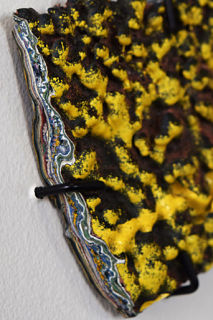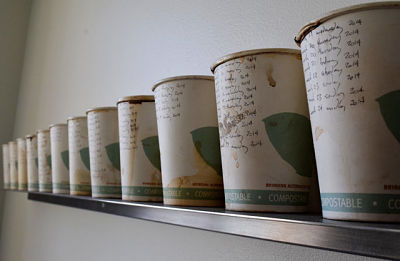Time has become irrevocable to the human experience, with humanity finding more and more means of quantifying, recording, and understanding it. Aside from the standard measures of clocks and calendars, there are natural measures that have been discovered through the advent of technology: carbon dating, geological study, and several other scientific methods. There are also the more mundane methods that we give our own personal significance or are impacted by human practices. All This Time is a collection of different temporal accounts stemming from the Anthropocene era, where human activity has had a profound influence on the environment.
Situated on the 10th floor of the Jackman Humanities Building at the University of Toronto, the exhibition consists of various artwork scattered throughout. The first set contains an impressive assortment of fossils and ore samples from the Royal Ontario Museum and from the collection of Jaclyn Quaresma and Kelly Jacvac. In addition to prehistoric Brachiopods, Trilobites, and plant material, samples of fordite and plastiglomerate – sedimentary rocks made from coalesced manmade substances. Automotive paint and plastic debris from factories spill into rivers and lakes, undergo the natural process of deposition and compaction, and create entirely new geologic materials. The fordite samples are attributed to Kelly Jazvac but they not at all related to her (apart from being of similar subject matter). Kelly Jazvac is the artist who uses the beautiful plastiglomerate rocks as readymades. She was actually involved in their discovery and naming. The presence of both natural and manmade artifacts represent both the past and present and the juxtaposing and yet interconnected relationship between them.
Following the theme of human intervention in temporal processes, Eric Cameron’s “Apple” intervenes the intrinsic process of decomposition. Over thirty years ago, he took an apple and coated it with layer upon layer of acrylic and gesso, enveloping the fruit in an airtight chrysalis. Because the coating is opaque and fully sealed, it is unclear as to the whether the apple has fully rotted or been preserved over all of these decades. Although it may seem that the intent was for conservation, there is a dilemma as to what is actually occurring – has nature prevailed or has humanity’s efforts to defy it?
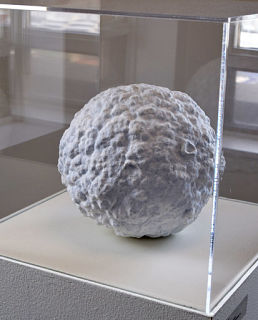 Eric Cameron, Apple, 1989. Acrylic and acrylic gesso on apple
Eric Cameron, Apple, 1989. Acrylic and acrylic gesso on apple
“Water Lily Invasion” by Tamiko Thiel deviates from the physical into the realm of the digital. Through augmented reality, Thiel is able to flood the small space with floating lily pads and water lilies, surrounding the viewer with a moving, waterless pond. Using either the provided tablet or the Layar app available in iOS and Android app stores, you are able to see the green sprouts slowly waver around them and flowers bloom before your eyes.
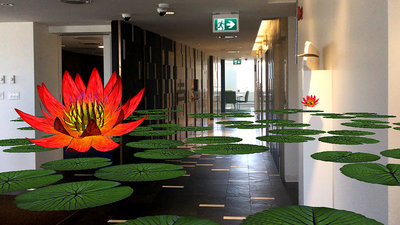 Tamiko Thiel, Water Lily Invasion, 2014. Augmented reality
Tamiko Thiel, Water Lily Invasion, 2014. Augmented reality
The exhibition also delves into historical records of time, ranging from the documentary to the rudimentary. Faith La Rocque’s “chisel to carve light thoughts” centers around colonialism, where European settlers, believing in the existence of gold in Georgia, eliminated or subjugated the native tribes, only to learn that the land was rich in marble. A Georgian marble slab rests on a pedestal as a feather rotates to gently graze it edge. It is assumed that eventually the rock shall degrade through repeated contact, yet there is no way to determine how long that process will take, or if it will happen at all.
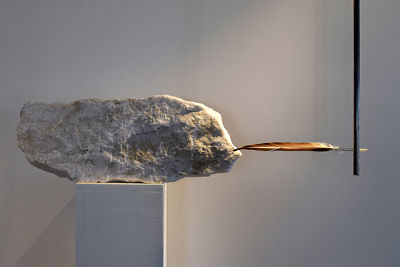 Faith La Rocque, chisel to carve light thoughts, 2014, Georgian marble, feather, rotator, steel tube, plinth. 168 x 31cm
Faith La Rocque, chisel to carve light thoughts, 2014, Georgian marble, feather, rotator, steel tube, plinth. 168 x 31cm
From there, the exhibition moves to Ken Nicol’s “100 cups of coffee.” Whereas La Rocque commemorates a crucial historical moments Nicol represents more personable, banal happenings. He would order cups of coffee and record how many uses he could get from a single cup before the barista offers another one, documenting the dates that each one is refilled until it reaches one hundred. Not only does it represent another form of temporal records, it also questions the notion of recycling.
 Ken Nicol, 100 cups of coffee, 2014, 14 x 111.7 x 10.1 cm
Ken Nicol, 100 cups of coffee, 2014, 14 x 111.7 x 10.1 cm
All This Time is an extensive and diverse array of time measurements and the impact that mankind has on many of the natural processes. It is about the constructs we create in order to quantify our own activities and that of nature, as well as nature’s means of quantifying the human experience.
Text and photo: Simon Termine
*Exhibition information: September 15, 2016 – June 15, 2017, Jackman Humanities Institute, St. George Street, Tenth Floor, Toronto. Gallery hours: Mon – Fri, 9 – 5 pm.

